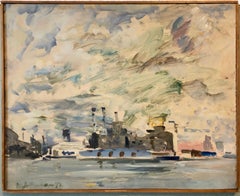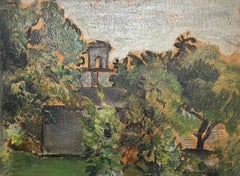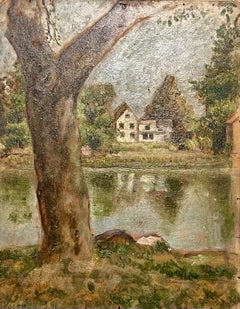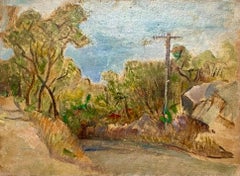Want more images or videos?
Request additional images or videos from the seller
1 of 5
Tibor GergelyOil Painting Man, Grocery Cart by Famed Childrens Book Illustrator Tibor Gergelyc.1950s
c.1950s
Price:$1,620
$1,800List Price
About the Item
- Creator:Tibor Gergely (1900, Hungarian)
- Creation Year:c.1950s
- Dimensions:Height: 3.9 in (9.91 cm)Width: 6.1 in (15.5 cm)Depth: 0.13 in (3.31 mm)
- Medium:
- Movement & Style:
- Period:
- Condition:good. minor wear. please see photos.
- Gallery Location:Surfside, FL
- Reference Number:1stDibs: LU3825095952
About the Seller
4.9
Platinum Seller
Premium sellers with a 4.7+ rating and 24-hour response times
Established in 1995
1stDibs seller since 2014
1,807 sales on 1stDibs
Typical response time: 1 hour
Authenticity Guarantee
In the unlikely event there’s an issue with an item’s authenticity, contact us within 1 year for a full refund. DetailsMoney-Back Guarantee
If your item is not as described, is damaged in transit, or does not arrive, contact us within 7 days for a full refund. Details24-Hour Cancellation
You have a 24-hour grace period in which to reconsider your purchase, with no questions asked.Vetted Professional Sellers
Our world-class sellers must adhere to strict standards for service and quality, maintaining the integrity of our listings.Price-Match Guarantee
If you find that a seller listed the same item for a lower price elsewhere, we’ll match it.Trusted Global Delivery
Our best-in-class carrier network provides specialized shipping options worldwide, including custom delivery.You May Also Like
"Money Lender" WPA American Scene Social Realism Modern Mid 20th Century
By Mervin Jules
Located in New York, NY
"Money Lender" WPA American Scene Social Realism Modernism Mid Century
Mervin M Jules (1912-1994
"The Money Lender"
15 1/2 x 20 1/2 inches
Oil on board, c. 1940s
Signed lower left
F...
Category
1940s American Modern Figurative Paintings
Materials
Oil, Board
Lawn Oil on cardboard, 39x30 cm
Located in Riga, LV
Lawn
Oil on cardboard, 39x30 cm
Laimdots Murnieks has said: "I am a sunny artist. The sun and a woman are the center of the world. It is not for nothing that the sun always comes ...
Category
Late 20th Century Modern Figurative Paintings
Materials
Oil, Cardboard
$1,436 Sale Price
20% Off
H 15.36 in W 11.82 in D 0.4 in
In the evening, 1950's, oil on cardboard, 46, 5х34 cm
Located in Riga, LV
In the evening, 1950-ties, cardboard, oil, 46,5х34 cm
Anatoly Lebedev (1935-2014)
Category
1950s Modern Landscape Paintings
Materials
Oil, Cardboard
$938 Sale Price
20% Off
H 13.39 in W 18.35 in D 0.4 in
Wind gestures. 1991. Oil on cardboard. 91, 5x85 cm
Located in Riga, LV
Wind gestures. 1991. Oil on cardboard. 91,5x85 cm
This depiction of trees shows artist Laimdots Murnieks as a master of nature representation.
Ev...
Category
Late 20th Century Modern Landscape Paintings
Materials
Oil, Cardboard
$8,425 Sale Price
20% Off
H 36.03 in W 33.47 in D 0.12 in
Rare Antique American Female Modernist Ashcan School Street Scene Oil Painting
Located in Buffalo, NY
Antique American ashcan school modernist cityscape painting by Judith Chamberlain (1893 - 1965). Oil on board. Framed. Signed. Excellent ready to hang condition.
Category
1920s Modern Landscape Paintings
Materials
Oil, Board
$2,475
H 13 in W 11 in D 2 in
Antique American Modernist Ashcan School Street Scene Nocturnal Signed Painting
Located in Buffalo, NY
Antique American modernist nocturnal street scene oil painting by Jerome Myers (1867 - 1940). Oil on board. Framed. Signed. Measuring 16 by 18 inches overall and 9 by 11 painting al...
Category
1890s Modern Landscape Paintings
Materials
Oil, Board
$1,820 Sale Price
20% Off
H 18 in W 16 in D 2 in
Original Antique American Landscape Fishing Delaware River Oil Painting Framed
Located in Buffalo, NY
A lovely scene adeptly painted by listed American artist and illustrator Jan Nosek (1876 - 1966) who was active in the late 19th and early 20th Century. This scene created in the ea...
Category
1910s American Modern Landscape Paintings
Materials
Oil, Board
A Pair of Modern Impressionist Landscape Oil Paintings Framed Female artist NY
Located in Buffalo, NY
A Pair of Modernist Landscapes by listed female artist Margaret Munro Stratton McLennan.
Margaret was a painter working in the early 20th Century in the Syracuse area. These charmi...
Category
1920s American Modern Landscape Paintings
Materials
Oil, Board
$600 Sale Price
20% Off
H 5 in W 7 in
Coney Island, Fourth of July
Located in Los Angeles, CA
Coney Island, Fourth of July, c. 1940s, oil on canvas applied to Masonite, signed upper right, 26 x 21 1/2 inches, presented in its original frame
During the 1930s and 40s, Coney I...
Category
1940s American Modern Figurative Paintings
Materials
Board, Oil, Canvas
Vintage Mid-Century Modern Seaside Figure Scene Oil Painting - Drift & Thought
Located in Bristol, GB
DRIFT AND THOUGHT
Size: 35 x 44 cm (including frame)
Oil on board
A mid-century modernist painting that presents a tranquil seaside scene, executed in oil onto board.
The painting ...
Category
Mid-20th Century Modern Figurative Paintings
Materials
Oil, Board
$1,092
H 13.78 in W 17.33 in
More From This Seller
View All1972 Gestural Oil Painting Boat in Harbor Figural Abstraction Raoul Middleman
By Raoul Middleman
Located in Surfside, FL
Raoul Middleman (born 1935 in Baltimore, Maryland) is an American painter. Middleman has been a member of the Maryland Institute College of Art faculty since 1961. American University Museum at the Katzen Center has described Middleman as a "Baltimore maestro [whose] nudes are not pretty—they are sagging, dimpled, and real. His cityscapes reveal the underbelly of post-industrial rot, his narrative paintings give contemporary life to his personal obsessions. They are intelligent, messy, and utterly masterful."
From an interview with RM "I was doing abstract art. Then Roy Lichtenstein came around, and I wanted to be current. I remember Grace Hartigan said, “You’ve gotta go to New York, seize destiny by the hand.” My friend Jon Schueler took my slides up to Eleanor Ward, who had the Stable Gallery. My Pop art paintings were discovered. I moved to New York into Malcolm Morley’s old loft down on South Street. Agnes Martin was upstairs... People who interest me come from different quarters. I knew guys around Schueler, like B.H. Friedman. But I also knew the Pop world pretty well – Al Hansen, Richard Artschwager, Lichtenstein. I became friends with Raoul Hague...
Category
1970s American Modern Landscape Paintings
Materials
Oil, Board
Simka Simkhovitch WPA Artist Oil Painting American Modernist Landscape w Tower
By Simka Simkhovitch
Located in Surfside, FL
Simka Simkhovitch (Russian/American 1893 - 1949)
This came with a small grouping from the artist's family, some were hand signed some were not.
These were studies for larger paintin...
Category
1930s American Modern Landscape Paintings
Materials
Oil, Board
Simka Simkhovitch WPA Artist Oil Painting American Modernist Landscape Pond Tree
By Simka Simkhovitch
Located in Surfside, FL
Simka Simkhovitch (Russian/American 1893 - 1949)
This came with a small grouping from the artist's family, some were hand signed some were not.
These were studies for larger paintin...
Category
1930s American Modern Landscape Paintings
Materials
Oil, Board
Simka Simkhovitch WPA Artist Oil Painting Gouache American Modernist Powerline
By Simka Simkhovitch
Located in Surfside, FL
Simka Simkhovitch (Russian/American 1893 - 1949)
This came with a small grouping from the artist's family, some were hand signed some were not.
These were studies for larger paintin...
Category
1930s American Modern Landscape Paintings
Materials
Oil, Gouache, Board
Charles Chartier 1951 French Cubist Modernist Oil Painting Surreal Paris Village
Located in Surfside, FL
Alex Charles Chartier, French, 1894-1957
Oil painting on board
1951
Quartier Plaisance, Paris village scene
Hand signed and dated '51 lower left.
Dimensions: 21" x 25-3/4", frame...
Category
Mid-20th Century Modern Landscape Paintings
Materials
Oil, Board
Bathers at the Quarry 1940s American Modernist Oil Painting WPA era
By Theresa Berney Loew
Located in Surfside, FL
Swimmers and sun tanners at the local watering hole.
Her birth name was Theresa Berney. At the time of her passing she was known as Theresa Loew.
Birth place: Baltimore
artist, blo...
Category
1940s American Modern Landscape Paintings
Materials
Oil, Board



